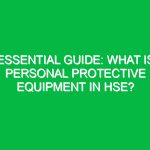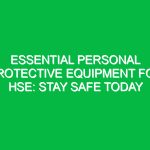Welcome team, today’s Toolbox Talk focuses on an essential aspect of workplace safety: preventing burn hazards and injury prevention. It is crucial to prioritize safety in our daily operations to ensure a secure working environment for all. Let’s delve into the key practices and guidelines that can help us mitigate burn hazards effectively.
The Importance of Burn Hazards and Injury Prevention
When it comes to Health, Safety, and Environment (HSE), preventing burn hazards is a critical component. Burns can occur from various sources, including heat, chemicals, electricity, and even friction. These injuries can range from minor discomfort to severe, life-threatening conditions. By understanding the risks associated with burn hazards and implementing preventive measures, we can significantly reduce the likelihood of accidents and injuries in the workplace.
Identifying Potential Burn Hazards
It is essential to be aware of the common sources of burn hazards in our work environment. These may include hot surfaces, open flames, electrical equipment, chemicals, and steam. By recognizing these potential risks, we can take proactive steps to minimize exposure and prevent accidents.
Best Practices for Burn Hazard Prevention
- Proper Training: Ensure that all employees receive comprehensive training on burn hazards, including how to identify risks and handle materials safely.
- Use Personal Protective Equipment (PPE): Wear appropriate PPE, such as gloves, aprons, and goggles, when working with hazardous materials or in high-temperature environments.
- Safe Handling Procedures: Follow established procedures for handling hot objects, chemicals, and electrical equipment to minimize the risk of burns.
- Emergency Response: Be familiar with emergency response protocols in case of a burn injury, including first aid measures and evacuation procedures.
Real-Life Example:
Imagine a scenario where a worker is handling a hot piece of equipment without wearing protective gloves. Inadvertently, they suffer a burn injury due to direct contact with the hot surface. This situation highlights the importance of following proper safety protocols and using the appropriate PPE to prevent such incidents.
Compliance with Regulations and Standards
It is essential to adhere to relevant regulations, standards, and company policies related to burn hazards and injury prevention. Compliance not only ensures a safe working environment but also fulfills legal obligations that protect both employees and the organization.
Key Regulations:
- Occupational Safety and Health Administration (OSHA): OSHA provides guidelines and regulations for workplace safety, including measures to prevent burn injuries.
- National Fire Protection Association (NFPA): NFPA standards cover fire safety and prevention, including protocols for handling flammable materials to reduce burn hazards.
Conclusion
As we conclude today’s Toolbox Talk on preventing burn hazards and injury prevention, remember that safety is everyone’s responsibility. By staying vigilant, following best practices, and maintaining compliance with regulations, we can create a safer work environment for all. Thank you for your attention and commitment to safety. Stay safe!


